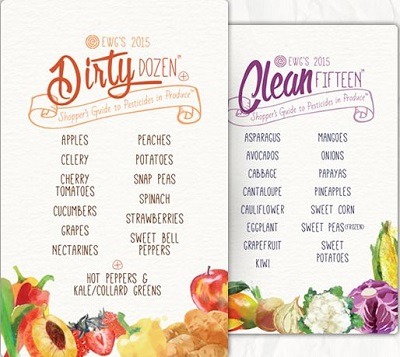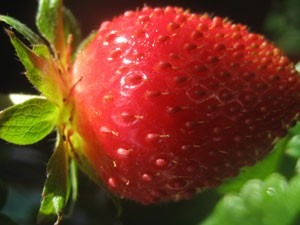We are all aware that fruit and veggies produced commercially, unless they are certified organic, have been exposed to pesticides at some stage in their growth and that they may still contain residues when we buy them. But do you know that there are some which are more contaminated than others? If ever you needed an incentive to grow your own, recent analyses of pesticide content provide just that. The resulting listings of the Dirty Dozen and the Clean Fifteen indicate which ones you will be best advised to grow yourself.
 The Environmental Working Group (EWG) in the USA has just released its 2015 Shopper’s Guide to Pesticides in Produce1. This large not-for-profit, independent group is comprised of many experts including scientists and other researchers. They analysed data from the US Department of Agriculture and the US Food and Drug Administration from 2013, covering 34,000 produce samples, and found that almost two-thirds contained pesticide residues.
The Environmental Working Group (EWG) in the USA has just released its 2015 Shopper’s Guide to Pesticides in Produce1. This large not-for-profit, independent group is comprised of many experts including scientists and other researchers. They analysed data from the US Department of Agriculture and the US Food and Drug Administration from 2013, covering 34,000 produce samples, and found that almost two-thirds contained pesticide residues.
All produce was tested as it would be consumed i.e. washed and peeled if appropriate. The Dirty Dozen was calculated from combining rankings of each product according to 6 criteria:
- Percent of samples tested with detectable pesticides
- Percent of samples with two or more detectable pesticides
- Average number of pesticides found on a single sample
- Average amount of pesticides found, measured in parts per million
- Maximum number of pesticides found on a single sample
- Total number of pesticides found on the commodity”1
The report’s key findings are:
- “99 percent of apple samples, 98 percent of peaches, and 97 percent of nectarines tested positive for at least one pesticide residue
- The average potato had more pesticides by weight than any other produce
- A single grape sample and a sweet bell pepper sample contained 15 pesticides
- Single samples of cherry tomatoes, nectarines, peaches, imported snap peas and strawberries showed 13 different pesticides apiece”1
Is this relevant to Australia?
You might say, “But Australian food has a reputation of being clean and green and U.S findings don’t relate to us”. But the few Australian studies that we could track down showed considerable overlap with the EWG findings. And commercial agriculture and pesticide use are similar in both countries.
In 2011, the Friends of the Earth (FoE) obtained a grant from the City of Yarra to produce a food guide and analysed Australian data from 2000 – 2011. Because monitoring of food is not performed consistently by a Federal government body, FoE analysed reports from the Australian Quarantine and Inspection Service (AQIS) Failing Food Reports, Food Standards Australia New Zealand (FSANZ) National Residue Surveys 2008-2010, FSANZ Total Diet Surveys 2003 and 2011, Victoria’s Department of Primary Industries (DPI) Produce Monitoring Reports 2007/8 –2008/9 – 2009/2010, Food Watch WA and other state based monitoring programs.2
| U.S. Produce1 | Australian Produce2 | ||
| 2010 | 2011 | 2013 | 2000 – 2011 |
| Celery | Apples | Apples | Apples |
| Peaches | Celery | Peaches | Pears |
| Strawberries | Strawberries | Nectarines | Strawberries |
| Apples | Peaches | Strawberries | Grapes |
| Blueberries | Spinach | Grapes | Lettuce |
| Nectarines | Nectarines (imported) | Celery | Nectarines |
| Sweet bell peppers | Grapes (imported) | Spinach | Peaches |
| Spinach | Sweet bell peppers | Sweet bell peppers | Tomatoes |
| Kale/Collard greens | Potatoes | Cucumbers | Apricots |
| Cherries | Blueberries | Cherry tomatoes | Carrots |
| Potatoes | Lettuce | Snap peas (imported) | Plums |
| Grapes (imported) | Kale/collard greens | Potatoes | Green beans |
#Listings are from highest to lowest levels of pesticides
Which pesticides?
The most frequent types of pesticides in food in Australia, according to the FoE study, are shown in the table below.
| Type of Pesticide | Percent of samples containing them |
| Insecticide | 39.5 |
| Fungicide | 32.1 |
| Synergist# | 5.6 |
| Herbicide | 4.1 |
| Other | 8.6 |
#Synergists block the ability of the target organism to break down the pesticide
These include a range of highly toxic chemicals such as chlorpyrifos, fenitrothion, difocol and dimethoate. Many are prohibited for use in the European Union and the U.S. Many persist in soil or find their way into waterways where they harm aquatic life.
An example is chlorpyrifos which is used commercially on a wide variety of crops, including fruits and vegetables. The safety advice prepared by manufacturers of commercial insecticides containing chlorpyrifos warns that it should not be used by householders in or around homes since it is too hazardous. Children and animals are more susceptible. It affects the nervous system and has been linked to interference with development of intelligence and to behaviour problems in children. It is toxic to bees, aquatic organisms including fish, and to some invertebrates and is currently under review by the National Registration Authority for Agricultural and Veterinary Chemicals. However, this chemical is present in some current garden products to kill lawn beetles and grubs.
 In 2008, Choice conducted a study on strawberries from 27 growers in all states (except Tasmania and South Australia) and found residues from 9 different pesticides with 17 samples containing 4 different chemicals3. Among the residues found were chlorpyrifos and dimethoate mentioned above.
In 2008, Choice conducted a study on strawberries from 27 growers in all states (except Tasmania and South Australia) and found residues from 9 different pesticides with 17 samples containing 4 different chemicals3. Among the residues found were chlorpyrifos and dimethoate mentioned above.
Regulation of allowable pesticide residues
In Australia, Food Standards Australia & New Zealand (FSANZ) and the Australian Pesticides and Veterinary Medicines Authority (APVMA) set Maximum Residue Limits (MRLs) for pesticide levels in fruit and vegetables. These limits are based on residue levels that might be expected if the use of the pesticide has been in accord with manufacturer’s instructions and with required withholding periods which are set so that produce is safe for consumption4. MRLs also take into account the amounts of each food likely to be consumed.
Monitoring of residue levels in food is conducted in an Australian total Diet Survey by FSANZ every 3 years and by the Department of Agriculture in its National Residue Survey. States and territories also conduct surveys such as Food Watch in Western Australia and the Sydney Markets Residue Survey. The latter tested 6,900 samples of fruit and vegetables from 1989 to 2005 and found that most (97.5%) complied with the MRLs. Only 171 samples exceeded acceptable levels5. However, testing does not sample every grower or processor or every food. Imported fruit and vegetables make up over 10% of the total available, but only about 5% are tested by the Australian Quarantine and Information Service (AQIS). Not all pesticides are tested for and not all survey results are publicly available.
Should I eat only home-grown or organic?
The degree of risk associated with consuming non-organic fruit and vegetables is difficult to determine for any given individual. It depends on the amounts and combinations of pesticide residues consumed, at what stage of life, whether any effects accumulate over a lifetime and whether monitoring actually includes samples that would not meet MRLs.
The EWG’s Clean Fifteen have the lowest levels of pesticides. Starting from lowest levels they are avocadoes, sweet corn, pineapple, cabbage, frozen peas, onion, asparagus, mango, papaya, kiwi fruit, eggplant, grapefruit, cantaloupe, cauliflower, sweet potato.
If you want to reduce levels of pesticides in your body when buying commercially grown produce, choose from the Clean Fifteen, buy less of the Dirty Dozen and seek out certified organic produce. Better still, grow you own with a focus on the Dirty Dozen – and avoid pesticide use in your garden.
For the full listing of produce examined by the EWG and FoE and more details on pesticides see the references below.
References
1. Environmental Working Group (2015) EWG’s 2015 Shopper’s Guide to Pesticides in Produce.
2. Friends of the Earth (2012) The dose makes the poison. (formerly available at: www.foe.org.au/sites/default/files/TheDoseMakesThePoisonFeb2012_0.pdf)
3. Choice (2014) Strawberries and pesticides. How do you pick the best and avoid an extra serving of chemicals?
4. Food Standards Australia & New Zealand (2013)
5. NSW Department of Primary Industries (2006) Spray sense. Information on Pesticide Issues, No. 3.
Related Articles:
Managing Rats with IPM
“You dirty rat!” This phrase embodies the frustration many feel towards rats in the garden. These uninvited guests seem ever-present, scuttling along…
Pest Alert: Polyphagous Shot-Hole Borer (PSHB)
The Polyphagous shot-hole borer (known as PSHB; Euwallacea fornicates) is a pest first detected in Australia 2021 in metropolitan Perth. Native to…


